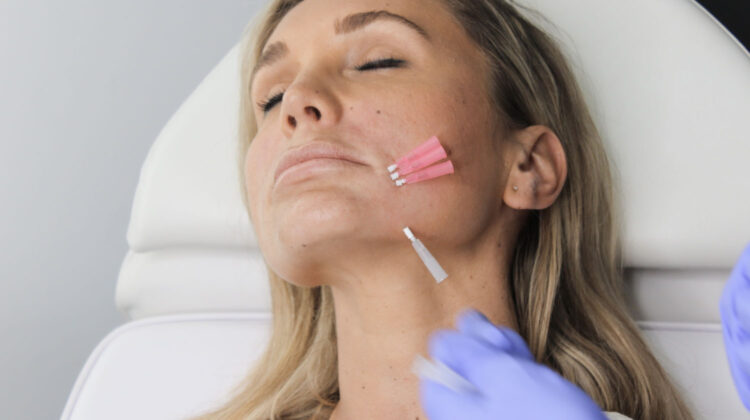
Are you considering a non-surgical facelift to rejuvenate your appearance? Have you heard of the treatment but are unsure of what it entails? In this comprehensive guide, we will explore the world of mono-thread lifting, a non-surgical facelift alternative that can provide impressive results without invasive surgery. We will discuss the procedure, its benefits, and what to expect during and after the treatment.
What is Mono Thread Lifting?
Mono thread lifting is a non-surgical facelift alternative that uses polydioxanone (PDO) threads to lift and tighten sagging skin, stimulate collagen production, and improve facial contouring. This minimally invasive aesthetic procedure offers a more natural-looking result than traditional facelift surgery, with minimal downtime and a lower risk of complications.
The Benefits of Mono Thread Lifting
There are several benefits to choosing as your rejuvenation treatment, including:
- Non-surgical: There is no need for invasive surgery or general anesthesia, reducing the risk of complications and ensuring a faster recovery time.
- Minimal downtime: Most patients can return to their daily activities within a day or two after the procedure.
- Natural-looking results: The threads’ gradual tightening and lifting effect provide a more natural appearance than traditional facelift surgery.
- Collagen production: The PDO threads stimulate natural collagen production, producing firmer skin over time.
- Versatile treatment: Can be used to target various areas of the face and neck, including the eyebrows, cheeks, jawline, and neck.
The Procedure: What to Expect
Depending on the treated areas, the mono-thread lifting procedure typically takes 30 minutes to an hour. Here’s what to expect during the treatment:
- Consultation: Your practitioner will discuss your concerns, assess your skin condition, and determine if you are a suitable candidate for the procedure.
- Preparation: The treatment area will be cleansed, and a local anesthetic may be applied to minimize discomfort during the procedure.
- Thread insertion: Your practitioner will insert the PDO threads under the skin in the targeted areas using a fine needle. The threads are strategically placed to provide optimal lifting and tightening effects.
- Thread tightening: Once the threads are in place, your practitioner gently tightens them to achieve the desired lift and contouring effect.
- Post-treatment care: After the procedure, your practitioner will provide aftercare instructions to ensure a smooth recovery and optimal results.
Recovery and Aftercare
One of the main advantages is the minimal downtime associated with the procedure. Most patients can return to daily activities within a day or two after treatment. However, following your practitioner’s aftercare instructions is essential, which may include the following.
- Avoiding strenuous activities and exercise for a few days
- Keeping the treated area clean and dry
- Avoiding excessive sun exposure and using sunscreen
- Refraining from rubbing or massaging the treated area
- Sleeping with your head elevated to minimize swelling
The Results: Before and After
The results are not immediate, as the treatment relies on the body’s natural collagen production to achieve its lifting and tightening effects. However, most patients will notice an improvement in their skin’s appearance within a few weeks, with optimal results visible after three to six months. The results can last up to two years, depending on age, skin condition, and lifestyle habits.
Potential Risks and Side Effects
Although mono thread lifting is a minimally invasive procedure, there are some potential risks and side effects to be aware of, including:
- Pain or discomfort at the treatment site
- Swelling, redness, or bruising
- Infection
- Thread migration or extrusion
- Asymmetry or uneven results
Choosing a qualified and experienced practitioner is essential to minimize the risk of complications and ensure the best possible outcome.
Choosing the Right Practitioner
Selecting the right practitioner for your mono-thread lifting procedure is crucial to achieving optimal results and minimizing potential risks. When choosing a practitioner, consider the following factors:
- Qualifications and experience: Ensure your practitioner has the appropriate qualifications and experience in performing procedures.
- Before and after photos: Ask to see before and after photos of previous patients to gauge the practitioner’s skill and expertise.
- Patient reviews: Read patient reviews and testimonials to get a sense of the practitioner’s reputation and the quality of their work.
- Consultation: Schedule a consultation to discuss your concerns, ask questions, and determine if the practitioner fits you.
Frequently Asked Questions
- -How much does mono thread lifting cost?
- -The cost of mono thread lifting varies depending on the practitioner, location, and the extent of the treatment.
- How long do the results last?
The results of mono-thread lifting can last up to two years, depending on factors such as age, skin condition, and lifestyle habits. A local anesthetic is typically applied before the procedure to minimize discomfort. Most patients report minimal pain during the treatment.
Conclusion
Mono thread lifting is an effective, non-surgical facelift alternative that can provide impressive results without invasive surgery. With minimal downtime and a lower risk of complications, this rejuvenation treatment is a popular choice for those seeking a more natural-looking and long-lasting solution to sagging skin, facial contouring, and collagen production. By choosing a qualified and experienced practitioner, you can ensure the best possible outcome for your procedure.

